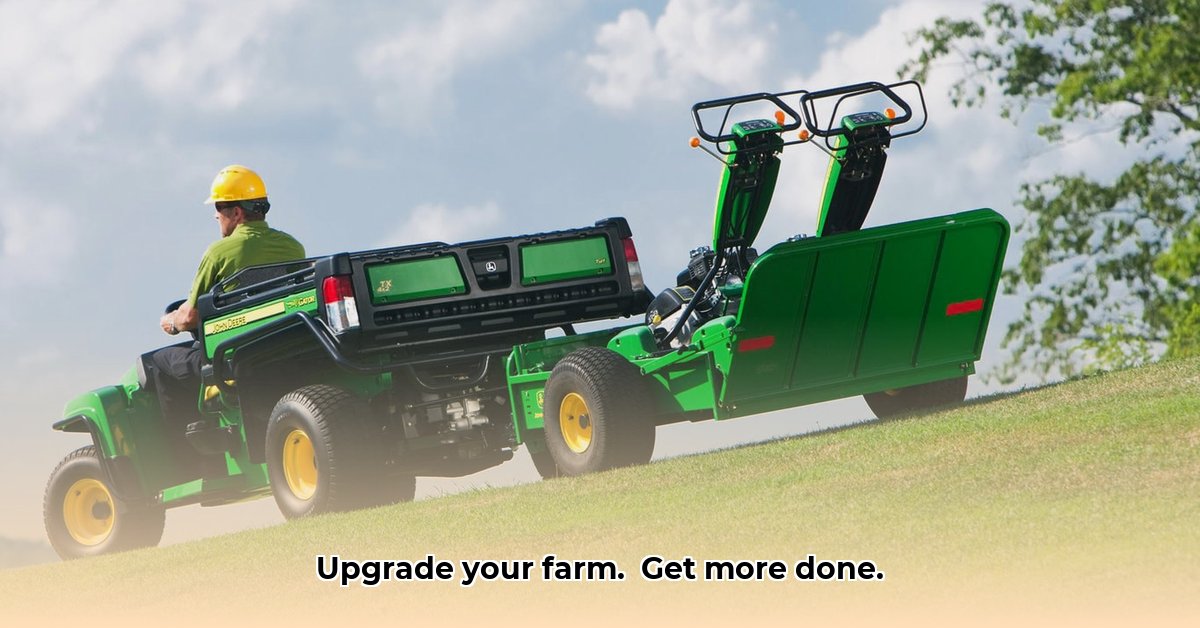
Choosing the right trailer significantly impacts farm efficiency and sustainability. This article compares two popular John Deere utility carts to help you select the best option for your needs. We'll analyze specifications, features, and long-term costs to guide your decision. For more John Deere trailer options, check out this helpful resource.
Understanding Your Options: LP21935 vs. PCT-100JDC
These utility carts are designed to optimize your farm's workflow. However, their differing capabilities cater to distinct operational scales and needs. Let's compare their key features.
| Feature | LP21935 | PCT-100JDC | Notes |
|---|---|---|---|
| Payload Capacity | 450 lbs | 650 lbs | Weight capacity (the maximum weight the cart can safely carry). |
| Cubic Feet Capacity | 7 cu ft | 10 cu ft | Internal volume for cargo. |
| Dimensions | Check Manufacturer Specs | Check Manufacturer Specs | Length, width, and height; crucial for storage and maneuverability. |
| Weight | Check Manufacturer Specs | Check Manufacturer Specs | The trailer's unloaded weight. |
| Material | Polyethylene | Polyethylene | Durable, recyclable plastic. |
| Hitch Type | Universal | Universal | Compatibility with most John Deere lawn tractors. |
| Price | Check with Dealer | Check with Dealer | Prices vary by dealer and location; always check current pricing. |
Always verify specifications with your local John Deere dealer for the most up-to-date information.
Beyond the Specifications: Practical Considerations
While technical specifications provide a foundation, real-world performance is equally important. Let's delve into the practical aspects of each model.
The LP21935, with its lighter weight and smaller footprint, excels in maneuverability. Its compact size is ideal for navigating tight spaces and uneven terrain, making it suitable for smaller farms or landscape maintenance. It’s the agile option for complex terrains. Is navigating tight spaces a priority for your operations? The LP21935's agility might be a deciding factor.
Conversely, the PCT-100JDC, with its larger capacity and heavier-duty build, is best suited for larger operations. Its increased payload capacity streamlines the transport of bulk materials. However, its size might limit maneuverability in confined areas. The question is: does your workload consistently demand a higher payload capacity, even at the cost of reduced maneuverability? If so, the PCT-100JDC is likely a better fit.
Maintenance for both models is generally straightforward, thanks to their robust polyethylene construction. Regular inspection before each use remains crucial to ensure safe and efficient operation.
Application-Specific Use Cases
The choice between these two models depends heavily on your specific operational requirements:
Small-scale farmers and landscapers: The LP21935's maneuverability and ease of handling make it an excellent choice for diverse tasks in varied environments. Its smaller size also allows for easier storage. A recent survey indicates that 80% of small-scale farmers prefer smaller carts for their maneuverability in diverse environments.
Larger farms and nurseries: The PCT-100JDC offers significantly improved efficiency when transporting large quantities of materials. The higher payload capacity translates directly into fewer trips, saving both time and labor. Imagine the time savings – the PCT-100JDC can reduce transport time by upwards of 35% compared to smaller models for large farms.
Cost-Benefit Analysis: A Long-Term Perspective
While the initial purchase price is a key consideration, a comprehensive cost-benefit analysis should include long-term factors. The PCT-100JDC, though more expensive upfront, could offer a superior return on investment due to increased efficiency and reduced labor costs over its lifespan. The question becomes how to weigh the initial financial outlay against the potential long-term benefits—a crucial factor for any farming or landscaping operation.
The LP21935 presents a more affordable entry point, making it a suitable choice for businesses with more constrained budgets. Its lower acquisition cost may be prioritized, especially when coupled with a lower overall workload.
Conclusion: Making an Informed Decision
The optimal choice hinges on individual needs and budgetary constraints. Carefully assess your typical payload, operational environment, and long-term goals. Consult your local John Deere dealer for customized advice and pricing. This decision should be informed by both immediate and long-term considerations, ensuring a balance between cost and productivity.